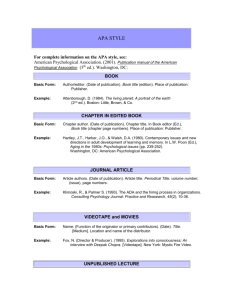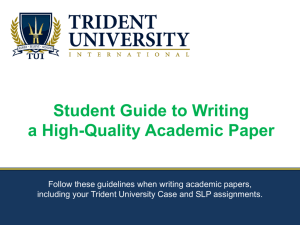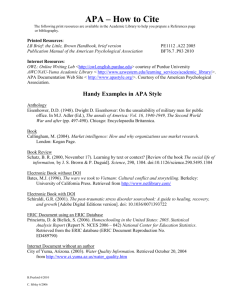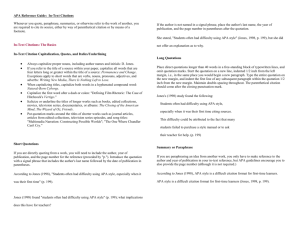In Text Citations APA 6th Edition
advertisement
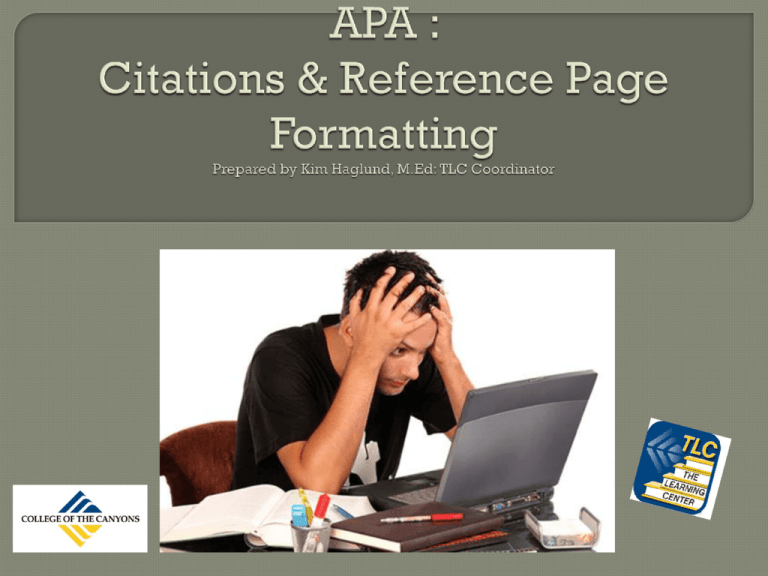
American Psychological Association is the most commonly used format for manuscripts in the Social Sciences. APA regulates • Style • In text Citations • References • A list of all sources used Term Papers Research Reports Empirical Studies Literature Reviews Theoretical Articles Methodological Articles Case Studies Information from sources must be cited. This acknowledges the author’s work, and allows the reader to access the information in the References section of your paper Follow the (author, date) method of in-text citation. If no date is available, write (n.d.) in place of the date The author's last name and the year of publication for the source should appear in the text, for example (Jones, 1998). Three key points in APA citations 1. 2. 3. Use author, date format whenever possible. If the source is quoted, you MUST include the page or paragraph number. If author’s name is not available, use the title of the document in place of the author’s name Three types of text citations: 1. Paraphrase (summary) 2. Short Quote = less than 40 words 3. Long Quote= more than 40 words A paraphrase is material from a source which has been summarized in your own words. All paraphrases must be cited, using the author’s last name and year of publication. No page number is required. If the author’s name is a part of the sentence structure, the year follows the author’s names in parenthesis. Quotation marks are not included. Example: Author’s last name, year of publication Berk (2007) found that children begin to play organized games with rules, once they reach school-age. When the author’s name is not part of the sentence structure (parenthetical citation), the author’s name and year of publication are included at the end of the citation, in parenthesis. Quotation marks are not included. Example: Studies conducted found that children begin to use organized play and games with rules at school-age (Berk, 2007). Author’s last name, year of publication If the author’s name is part of the sentence, place only the year of publication in parentheses. • Example: Berk (2007) found that children begin to play organized games with rules, once they reach school-age. When the author’s name is not part of the sentence, place both the name and the year, separated by a comma, in parentheses • Example: Studies conducted found that children begin to use organized play and games with rules at school-age (Berk, 2007). A direct quote is information included in a paper, which is taken directly from the source. Short quotes = less than 40 words • Enclosed within quotation marks • Cited using the author’s last name, year of publication, and page number (or paragraph number, if page number is not available.) “Reading makes use of many skills at once, taxing all aspects of our information-processing systems” (Berk, 2007, p. 306). Author’s last name, year of publication, page # Research has shown that “mathematics teaching in elementary school builds on and greatly enriches children’s informal knowledge of number concepts and counting” (Berk, 2007, p. 307). Author’s last name, year of publication, page # Quotes over 40 words must be block formatted. Quotation marks are not used. The entire block quote is indented five spaces, and doublespaced. Example: Notice: the quote is block formatted (indented 5 spaces), but quotation marks are not used Berk (2007) found the following to be true: We have seen that middle childhood brings major advances in perspective taking, the capacity to imagine what other people may be thinking and feeling. These changes support self-self esteem, understanding of others, and a wide variety of social skills. (p. 336) Note: with 3 or more authors, after the first text citation, only the first author is named. The remaining authors are included as “et al.” Table 6.1 Basic Citation Styles Type of Citation First Citation in Text Subsequent Citations in Text One Author Two Authors Walker (2000) Walker (2000) Walker and Allen (2004) Walker and Allen (2004) (Walker & Allen, 2004) Three Authors Bradley, Ramirez, and Soo (1999) Bradley, Ramirez, Soo, and Walsh (2006) Walker, Allen, Bradley, Ramiriz, and Soo (2008) Wasserstein et al. (2005) National Institute of Mental Health (NIMH, 2003) University of Pittsburgh (2005) Four Authors Five Authors Six + Authors Groups (abbrev.) Groups (no abbrev.) Bradley et al. (1999) Bradley et al. (2006) Walker et al. (2008) Wasserstein et al. (2005) NIHM (2003) Parenthetical Format, First Citations (Walker, 2007) Parenthetical Format, Second Citations (Walker, 2007) (Walker & Allen, 2004) (Bradley, Ramirez, & (Bradley et al., 1999) Soo, 1999) (Bradley, Ramirez, Soo, (Bradley et al., 2006) & Walsh, 2006) (Walker, Allen, Bradley, (Walker et al., 2008) Ramirez, & Soo, 2008) (Wasserstein et al., 2005) (National Institute of Mental Health [NIMH], 2003) University of Pittsburgh (University of Pittsburgh, (2005) 2005) (Wasserstein et al., 2005) (NIMH, 2003) (University of Pittsburgh, 2005) (APA Publication Manual, 2009, 6.11-6.15) When citing an electronic document, whenever possible, cite it in the author-date style. If electronic source lacks page numbers, locate and identify paragraph number or paragraph heading Example: Recent research has yielded similar results (Smith, 1997, para. 6). http://owl.english.purdue.edu/owl/resource/560/03/ When the author’s name is designated as “Anonymous” cite in text the word Anonymous followed by a comma and the date. Example: (Anonymous, 1998) In the Reference list, an anonymous work is alphabetized by the word Anonymous as the author with the remaining publication data When a work has no identified author, cite the title of the reference and the year. If it is a long title, use the first few words • Use quotation marks around the title of an article, a chapter or a webpage • Italicize the title of a journal, a book, a brochure or a report. Examples Use the title of the article with the year in the citation when no author is named. • Recent research reveals (“Six Sites Meet,” 2006) significantly… Full publication title is “Six sites meet for comprehensive anti-gang initiative conference.” Notice the title was shortened for the in text citation because the title was long • The book College Bound Seniors (2008) asserts that… Use the title of the book with the year in the citation when no author is named. APA (2010), section 6.15 Because there is no author listed for these sources, use the title in place of the author’s name in the citation and on the References page, in alphabetical order. Examples • Recent research reveals (“Six Sites Meet,” 2006) significantly… • The book College Bound Seniors (2008) asserts that… On the Reference page, use the title in the place of the author’s name. Place in alphabetical order. Because there is no author listed for these sources, use the title in place of the author’s name in the citation and on the References page, in alphabetical order. Examples The name of the publication is NOT part of the sentence structure, so both the title and the year of publication are placed in parentheses. • Recent research reveals (“Six Sites Meet,” 2006) significantly… • The book College Bound Seniors (2008) asserts that… The name of the book is part of the sentence structure; it is the subject of the sentence, so only the year of publication is placed in parentheses. References cited throughout text are listed in alphabetical order by author’s last name on a new page following the text. • Hanging indentation is used for all references. • Entire reference page is double-spaced Center the title References at the top of the page • Do not bold, underline, or use quotation marks for the title. APA Sample Reference Page: http://www.vanguard.edu/uploadedFiles/Psychology/references.pdf APA reference format always follows this basic formula regardless of the type of source. References Formula Author(s) Last Name, First Initial. (Year of Publication). Title, Publication Data. • Author (s) last names, include ALL authors as they are listed • Year of publication--if no date is available, write (n.d) • Title of the book or title of the article • Publication data = where do I locate the source material? For example: Book publishing company information, full website address, journal name, newspaper name, magazine name or include issue and page numbers for journals, newspapers and magazines Journal article with DOI: Murzynski, J., & Degelman, D. (1996). Body language of women and judgments of vulnerability to sexual assault. Journal of Applied Social Psychology, 26, 1617-1626. doi:10.1111/j.15591816.1996.tb00088.x 1. Journal article without DOI: Koenig, H. G. (1990). Research on religion and mental health in later life: A review and commentary. Journal of Geriatric Psychiatry, 23, 23-53. 2. Journal article without DOI, retrieved online 3. • [Note: For articles retrieved from databases, include the URL of the journal home page. Database information is not needed. Do not include the date of retrieval.]: Aldridge, D. (1991). Spirituality, healing and medicine. British Journal of General Practice, 41, 425-427. Retrieved from http://www.rcgp.org.uk/publications/bjgp.aspx (Degelman, 2009) Book: Paloutzian, R. F. (1996). Invitation to the psychology of religion (2nd ed.). Boston: Allyn and Bacon. 4. Informally published Web document: Degelman, D. (2009). APA style essentials. Retrieved from http://www.vanguard.edu/faculty /ddegelman/detail.aspx?doc_id=796 5. (Degelman, 2009) Informally published Web document (no date): Nielsen, M. E. (n.d.). Notable people in psychology of religion. Retrieved from http://www.psywww.com/psyrelig/psyrelpr.ht m 6. Informally published Web document (no author, no date): Gender and society. (n.d.). Retrieved from http://www.trinity.edu/~mkearl/gender.html 7. (Degelman, 2009) 8. Abstract from secondary database: Garrity, K., & Degelman, D. (1990). Effect of server introduction on restaurant tipping. Journal of Applied Social Psychology, 20, 168-172. Abstract retrieved from PsycINFO database. Article or chapter in an edited book: Shea, J. D. (1992). Religion and sexual adjustment. In J. F. Schumaker (Ed.), Religion and mental health (pp. 7084). New York: Oxford University Press. 9. (Degelman, 2009) Diagnostic and Statistical Manual of Mental Disorders: American Psychiatric Association. (2000). Diagnostic and statistical manual of mental disorders (4th ed., text rev.). Washington, DC: Author. 10. (Degelman, 2009) American Psychological Association (2009). The Basics of APA style tutorial. Retreived from http://www.apastyle.org/learn/tutorials/basics-tutorial.aspx American Psychological Association (2010). Publication Manual of the American Psychological Association (6th ed), Washington, DC: Author Berk, L. (2007). Development through the lifespan (4th ed.). Boston: Allyn and Bacon. Degelman, D. (2009). APA style essentials. Retrieved from http://www.vanguard.edu/faculty/ddegelman/d etail.aspx?doc_id=796 Purdue Online Writing Lab (2010). Retrieved from http://owl.english.purdue.edu/owl/resource/560/03/ Schor, E. (1995). Caring for your school-age child; ages 5-12. New York: Bantam Books.



